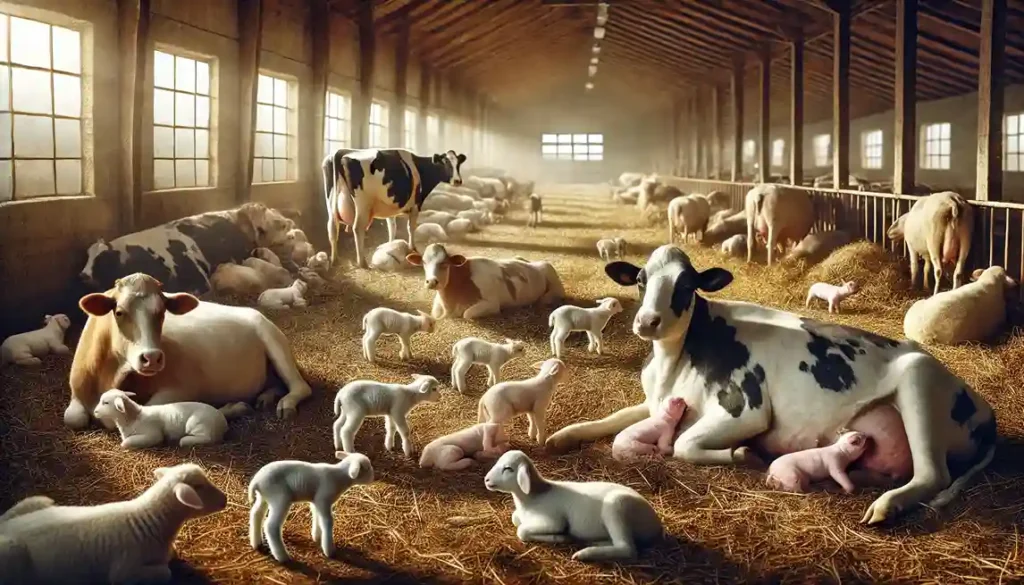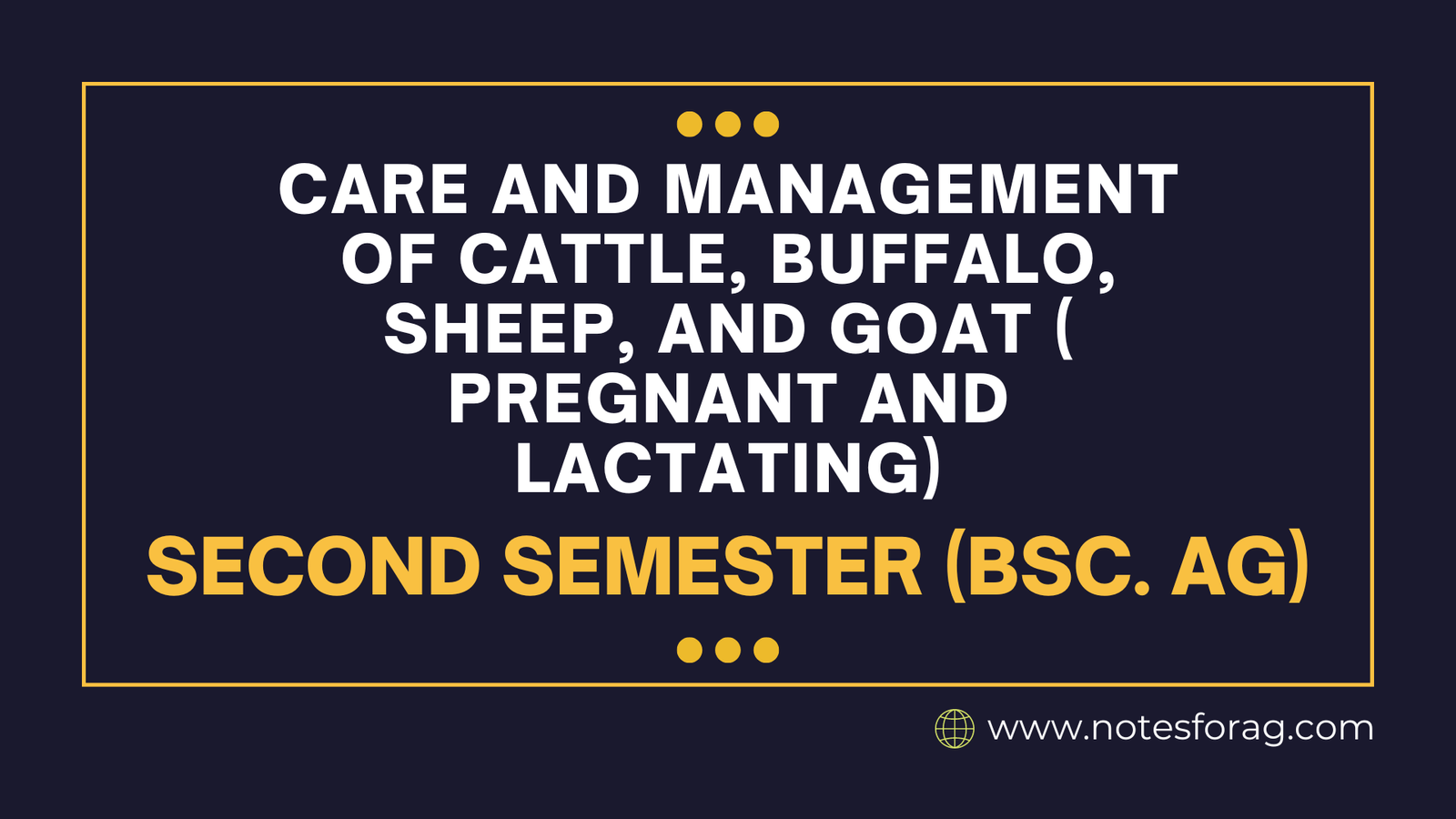Care and management of pregnant and nursing cattle, buffalo, sheep, and goats are essential for their health, production, and the welfare of their progeny. During these crucial times, their physiological demands must be supported by a stress-free environment, a healthy diet, and routine veterinarian exams. Successful mating and a high milk output also depend on other important measures like giving clean and pleasant housing, keeping an eye out for any symptoms of disease or difficulties, and making sure animals are well hydrated. In addition to improving overall farm production and sustainability, good care and management during pregnancy and lactation also improves animal comfort.
Table of Contents
Nutritional Requirements during Pregnancy
For pregnant buffalo, sheep, goats, and cattle, proper diet is critical to their health since it affects the fetus’s growth as well as the mother’s overall health. The nutritional requirements of these animals change as the pregnancy progresses, requiring precise feed intake adjustments to provide a well-balanced diet full of vital nutrients.
In antenatal care, certain vitamins and minerals are essential. For example, vitamins A, D, and E promote a number of physiological activities, including as vision, bone formation, and immunological response, while calcium and phosphorus are essential for the development of the fetal skeleton. In addition to being vital for general health, trace minerals like iodine, zinc, and selenium also guard against shortages that might cause problems down the road.
For pregnant cattle, a balanced feed comprising both concentrates and roughage is necessary to fulfill their fluctuating energy needs. The need for energy increases dramatically throughout pregnancy, especially in the latter trimester when the fetus is growing quickly. As a result, it’s critical to modify feed formulas appropriately to guarantee a sufficient amount of lipids, proteins, and carbs. Particularly important for the development of fetal tissue is protein, which has to be consumed in suitable amounts.
One useful tactic to fill in some dietary deficits is supplementation. Mineral blocks and fortified feeds, for instance, might offer extra nutrients that the typical diet might not include in appropriate amounts. To prevent over supplementation, which can result in toxicity, it is crucial to check consumption.
Proactive management is necessary for common dietary issues including maintaining body condition and preventing metabolic diseases. Dietary adjustments to maintain optimal health can be aided by routinely tracking body weight and condition ratings. Additionally, the general wellbeing of pregnant cattle can be improved by giving them access to clean water, high-quality feed, and reducing stress.
Species-Specific Care and Management

The specific care and management for specific species are described below:
Cattle and Buffalo
1. Pregnancy Care:
- Feed: Give premium concentrates and forages.
- Body Condition: To avoid difficulties, maintain an ideal Body Condition Score (BCS).
- Exercise: To support optimal health, permit moderate exercise.
2. Lactation Care:
- Milking routine: Establishing a consistent and gentle milking regimen is important.
- Udder Health: Keep an eye on your udders to avoid mastitis. Maintain the udder dry and clean.
- Feed: To satisfy the increased energy demands of breastfeeding, increase feed intake.
Sheep and Goats
1. Pregnancy Care:
- Nutrition: Offer premium roughage along with more feed.
- Pregnancy scanning: To efficiently handle several deliveries, do pregnancy scanning.
- Body Condition: Keep up a healthy BCS, especially during the latter trimester.
2. Lactation Care:
- Feed: Provide feeds that are high in calories and protein.
- Lamb/Kid Care: Make sure that within the first 24 hours, lambs and youngsters receive an adequate amount of colostrum.
- Health Monitoring: Continually look out for symptoms of mastitis and other illnesses.
Management Practices during Lactation
For cattle, buffalo, sheep, and goats to remain healthy and productive throughout the lactation phase, effective care and management techniques are necessary. In order to preserve udder health and guarantee enough milk output, proper milking practices are essential. To encourage continuous milk flow and avoid mastitis, it is essential to follow a regular milking schedule, often twice a day. In order to prevent infections, modern milking equipment has to be cleaned and maintained properly.
It is vital to keep the udder healthy. It is important to regularly check the udders for lumps, anomalies, or indications of inflammation. Veterinarian action is required as soon as any problems are identified. Keeping the udders clean both before and after milking can help lower the risk of infection. Another way to keep udder health is to apply teat dips after milking.
During lactation, nutritional modifications are essential to support milk supply and quality. A well-balanced meal that is high in proteins, energy, vitamins, and minerals ought to be offered. High-quality forages, cereals, and supplemental feeds can improve milk output in cattle and buffalo. Similarly, nutrient-dense meals that fulfill the increased energy requirements of lactating sheep and goats are beneficial to them. Sufficient supplementation with minerals, such phosphorus and calcium, is essential to ward off deficiencies and advance general well-being.
Another important part of managing lactation is staying hydrated. Water intake during lactation is crucial for the production of milk in animals. It is crucial to guarantee that there is always clean, fresh water available. Animal health and milk production can be negatively impacted by dehydration.
For nursing animals to stay healthy, rest and stress reduction are essential. Reducing stress and promoting recuperation can be achieved by offering a clean, pleasant resting environment. Reducing disruptions and handling during the milking process can also help to reduce stress and improve milk output.
Sustaining appropriate home circumstances is necessary to create a lactation-friendly atmosphere. To keep the animals happy, they need proper care and management such as: bedding, enough ventilation, and shelter from bad weather. Infections can be avoided and general hygiene can be enhanced by routinely cleaning and disinfecting the living space. Care and management of pregnant and lactating cattle, buffalo, sheep, and goats are crucial for their health, productivity, and the well-being of their offspring.
Frequently Asked Question(FAQ)
What is the best diet for pregnant cattle and buffalo?
A well-rounded diet full of premium concentrates, hay, silage, and forages. Make sure your protein, mineral, and vitamin consumption is sufficient.
What are the common nutritional deficiencies in pregnant and lactating livestock?
Vitamins A and D, calcium, and phosphorus deficits are common. These may be avoided with a balanced diet and regular supplements.
Related Articles

